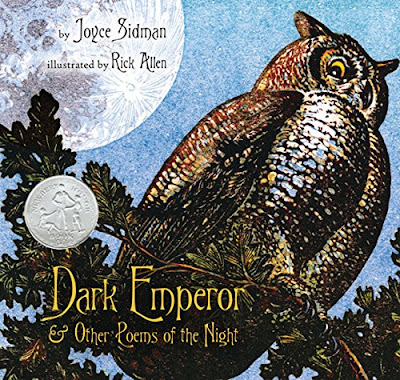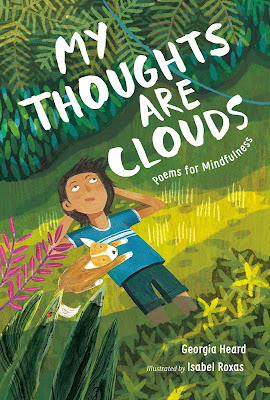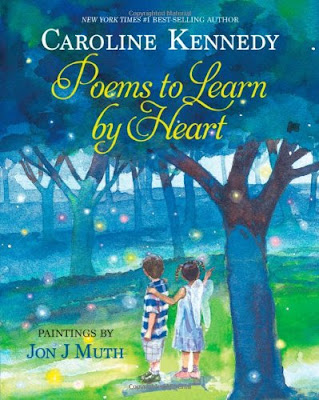Dark Emperor & Other Poems of the Night
Bibliography: Sidman, Joyce. Dark Emperor & Other Poems of the Night. Ill. by Rick Allen. New York: Houghton Mifflin Books for Children, 2010. ISBN: 978-0547152288
Summary:
Dark Emperor & Other Poems of the Night is a lyrical tribute to the living beings that thrive in the nighttime. From snails at moonrise and the oak after dark, to crickets, mushrooms, and a baby porcupette, Joyce Sidman welcomes the reader into a secret nocturnal world. Twelve poems in varying styles are paired with Rick Allen’s stunning wood print illustrations. The poems are complemented by informational sidebars presenting scientific facts about the creatures and their curious habits. The book begins with a full-spread illustration of a majestic owl soaring at dusk, and it ends with a full spread illustration of the same scene at dawn, the owl perched among the branches. A colorful table of contents introduces the poems, and a glossary of terms draws the book to a close.Analysis:
In this Newbery Honor Book, Joyce Sidman’s elegantly crafted nature poetry finds its soulmate in the illustrations of Rick Allen. The book’s dust jacket depicts a dappled owl peering down at the reader from its leafy branch against a speckled sky and a large looming moon. The dramatic title Dark Emperor & Other Poems of the Night completes the effect and draws the reader in. Inside, two full-spread illustrations, at the beginning and end of the book, frame the poems from dusk to dawn and cause the reader to pause and appreciate their stunning texture and color. Each illustration is carved into linoleum blocks and hand printed with black ink, then pigmented with vibrant gouache watercolor.
The artwork is a perfect mirror to Joyce Sidman’s luminous and textured language. In the opening poem, “Welcome to the Night,” she crafts stanzas with alliteration, rhyme, and onomatopoeia. “To all of you who crawl and creep, / who buzz and chirp and hoot and peep, / who wake at dusk and throw off sleep: / Welcome to the night.” The final phrase and title of the poem is repeated at the end of each stanza, creating a delightful opportunity for choral reading. Beside an illustration of a raccoon dipping its paws into a stream floats an informational sidebar revealing scientific facts about the nocturnal creature. Although these prose passages are meant to inform, Sidman’s language is no less poetic than the poems themselves. “As night falls, the nocturnal world wakes. Mice begin to stir, moths flutter into the starlight, and deer step out from hidden places to roam and forage.” In these informational passages, readers will experience words like abdomen, echolocation, spinnerets, stridulation, and ubi sunt, all of which are defined in an attractively designed glossary in the back of the book. These more challenging words are sprinkled sparingly throughout, so readers will not be overwhelmed but gently encouraged to explore new words with curiosity.
Sidman presents a range of poetic styles including a concrete poem, “Dark Emperor,” which takes the shape of a great horned owl, the words tapering down to its blunt tail feathers. A small, fleeing stanza appears to its side, representing an escaping mouse. Another poem, in ballad form, is the “Ballad of the Wandering Eft.” The poem tells the tale of this amphibious creature, similar to a newt or salamander, who is born in the water and moves onto land for two to four years, roving the wet woods, protected by its bright scarlet color, before returning to the water, fading to an olive green and growing its gills again. This natural plot structure lends itself beautifully to a ballad with a repeated refrain: “For it’s wild and it’s windy / way out in the woods, / where the moss grows like candy / and the hunting is good, / where the rain falls from heaven / and mud’s underfoot. / It’s wild and it’s windy / way out in the woods.” Even the moon has its say in “Moon’s Lament.” The personified celestial body wonders “Where are the bright dips of fireflies?” mourning the end of the night in an ubi sunt, which the glossary defines as “a style of medieval poetry that laments the loss of heroic, beautiful things.”
Gloriously poetic and equally scientific, Dark Emperor will mesmerize and inform readers with its beautifully crafted language and its window into the wonders of the natural world. A rare gem in the tradition of Mary Oliver. Grade 3 and up.
Excerpt:
“Snail at Moonrise”
Each night, Snail
unhooks himself from earth,
climbs a slick trail of silver
up, up
the horizon of log,
up stems of leaves
to their dewy tips,
seeking
with his tiny sandpaper tongue
morsels of green
to mix in his dark, moist body
and spin
into whorls of light.
Shell-maker
Moon-maker
gleaming silver-bright.
Each night:
darkness
into
light.
Activity:
Introduce “Snail at Moonrise” by showing readers the accompanying illustration.
What details do you notice?
Read the poem once.
Next, read the nonfiction sidebar.
Did you learn anything new about snails? Now that you know a little more about snails, listen to the poem again.
Read the poem again.
Did you notice anything that you didn’t before?
Invite readers to create snail art with cut paper, markers, or watercolors.




Comments
Post a Comment